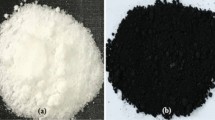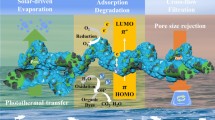Abstract
Zinc oxide/polydopamine nanoparticles/graphene oxide (ZnO/PDA/GO) membranes are fabricated combining chemical and physical methods. In this process, magnetron sputtering is used to deposit ZnO seed layers for further growing uniform and dense ZnO nanorod arrays by hydrothermal method, and then ZnO nanorod arrays is decorated using PDA and GO. The surface morphologies and microstructure characterization indicate that ZnO/PDA/GO membrane with the layered stacked structures is successfully fabricated. Interestingly, ZnO/PDA/GO membrane not only reduced the pore size compared with the original Cu mesh, but also has hydrophilic/underwater superoleophobicity with an underwater oil contact angle higher than 150°. The oil–water separation process driven by gravity shows that the separation efficiency of the membrane for various oil–water mixtures is more than 99%, and it has excellent corrosion resistance and cycle stability. In addition, based on density functional theory (DFT), the double-sided saturated adsorption of water molecules on the model is constructed. The simulation results confirm theoretically that the oil–water separation of underwater superhydrophobic membrane is indeed due to the formation of hydration layer on the membrane surface. These results provides a new idea for the design and development of functional membranes for oil–water separation.










Similar content being viewed by others
Data availability
All data generated or used during the study appear in the submitted article.
References
Y.Y. Liu, X. Wang, S.Y. Feng, Nonflammable and magnetic sponge decorated with polydimethylsiloxane brush for multitasking and highly efficient oil-water separation. Adv. Funct. Mater. 29, 1902488 (2019). https://doi.org/10.1002/adfm.201902488
G.H. Chen, Electrochemical technologies in wastewater treatment. Sep. Purif. Technol. 38, 11 (2004). https://doi.org/10.1016/j.seppur.2003.10.006
A.A. Al-Shamrani, A. James, H. Xiao, Destabilisation of oil-water emulsions and separation by dissolved air flotation. Water Res. 36, 1503 (2002). https://doi.org/10.1016/S0043-1354(01)00347-5
X.B. Hu, Y. Yu, J.E. Zhou, Y.Q. Wang, J. Liang, X.Z. Zhang, Q.B. Chang, L.X. Song, The improved oil/water separation performance of graphene oxide modified Al2O3 microfiltration membrane. J. Membr. Sci. 476, 200 (2015). https://doi.org/10.1016/j.memsci.2014.11.043
X.J. Liu, L. Ge, W. Li, X.Z. Wang, F. Li, Layered double hydroxide functionalized textile for effective oil/water separation and selective oil adsorption. ACS Appl. Mater. Interfaces 7, 791 (2015). https://doi.org/10.1021/am507238y
R.N. Zhang, Y.N. Liu, M.R. He, Y.L. Su, X.T. Zhao, M. Elimelech, Z.Y. Jiang, Antifouling membranes for sustainable water purification: strategies and mechanisms. Chem. Soc. Rev. 45, 5888 (2016). https://doi.org/10.1039/C5CS00579E
X.J. Zhang, Y.X. Zhao, S.J. Mu, C.M. Jiang, M.Q. Song, Q.R. Fang, M. Xue, S.L. Qiu, B.L. Chen, UiO-66-coated mesh membrane with underwater superoleophobicity for high-efficiency oil-water separation. ACS Appl. Mater. Interfaces 10, 17301 (2018). https://doi.org/10.1021/acsami.8b05137
J.L. Yong, F. Chen, Q. Yang, J.L. Huo, X. Hou, Superoleophobic surfaces. Chem. Soc. Rev. 46, 4168 (2017). https://doi.org/10.1039/C6CS00751A
X.F. Wang, J.Y. Yu, G. Sun, B. Ding, Electrospun nanofibrous materials: a versatile medium for effective oil/water separation. Mater. Today 19, 403 (2016). https://doi.org/10.1016/j.mattod.2015.11.010
T.F. Huang, L. Zhang, H.L. Chen, C.J. Gao, Sol-gel fabrication of a non-laminated graphene oxide membrane for oil/water separation. J. Mater. Chem. A 3, 19517 (2015). https://doi.org/10.1039/C5TA04471E
W.J. Tang, D. Sun, S.H. Liu, B.B. Li, W.W. Sun, J.W. Fu, B.J. Li, D.D. Hu, J.T. Yu, One step electrochemical fabricating of the biomimetic graphene skins with superhydrophobicity and superoleophilicity for highly efficient oil-water separation. Sep. Purif. Technol. 236, 116293 (2020). https://doi.org/10.1016/j.seppur.2019.116293
X.Y. Li, D. Hu, K. Huang, C.F. Yang, Hierarchical rough surfaces formed by LBL self-assembly for oil-water separation. J. Mater. Chem. A 2, 11830 (2014). https://doi.org/10.1039/C4TA01569J
Y.R. Chen, L.H. Chen, C.H. Chen, C.C. Ko, A. Huang, C.L. Li, C.J. Chuang, K.L. Tung, Hydrophobic alumina hollow fiber membranes for sucrose concentration by vacuum membrane distillation. J. Membr. Sci. 555, 250 (2018). https://doi.org/10.1016/j.memsci.2018.03.048
A. Huang, C.C. Kan, S.C. Lo, L.H. Chen, D.Y. Su, J.F. Soesanto, C.C. Hsu, F.Y. Tsai, K.L. Tung, Nanoarchitectured design of porous ZnO@copper membranes enabled by atomic-layer-deposition for oil/water separation. J. Membr. Sci. 582, 120 (2019). https://doi.org/10.1016/j.memsci.2019.03.093
Q. Zhou, N. Yang, L.H. Zhang, L.F. Zhang, J.S. Li, X.D. Yang, F.F. Peng, Y.L. Sun, Structural tailored ZnO@Cu2O heterostructure-decorated mesh with dual functionalities for oil/water separation and photodegradation. J. Alloys. Compd. 896, 162763 (2022). https://doi.org/10.1016/j.jallcom.2021.162763
J.J. Ding, M.Q. Wang, Enhanced visible photoluminescence emission from multiple face-contact-junction ZnO nanorods coated with graphene oxide sheets. J. Appl. Phys. 115, 214304 (2014). https://doi.org/10.1063/1.4881176
F. Kazemi, Y. Jafarzadeh, S. Masoumi, M. Rostamizadeh, Oil-in-water emulsion separation by PVC membranes embedded with GO-ZnO nanoparticles. J. Environ. Chem. Eng. 9, 104992 (2021). https://doi.org/10.1016/j.jece.2020.104992
J. Wang, Q. Du, J.S. Luan, X.B. Zhu, J.H. Pang, ZnO nanoneedle-modified PEEK fiber felt for improving anti-fouling performance of oil/water separation. Langmuir 37, 7449 (2021). https://doi.org/10.1021/acs.langmuir.1c00838
X.Y. Liu, S.T. Feng, C.H. Wang, D.Y. Yan, L. Chen, B. Wang, Wettability improvement in oil–water separation by nano-pillar ZnO texturing. Nanomaterials 12, 740 (2022). https://doi.org/10.3390/nano12050740
S. Stankovich, D.A. Dikin, R.D. Piner, K.A. Kohlhaas, A. Kleinhammes, Y.Y. Jia, Y. Wu, S.B.T. Nguyen, R.S. Ruoff, Synthesis of graphene-based nanosheets via chemical reduction of exfoliated graphite oxide. Carbon 45, 1558 (2007). https://doi.org/10.1016/j.carbon.2007.02.034
J.J. Ding, M.Q. Wang, X.Y. Zhang, C.X. Ran, J.Y. Shao, Y.C. Ding, Physical deoxygenation of graphene oxide paper surface and facile in situ synthesis of graphene based ZnO films. Appl. Phys. Lett. 105, 233106 (2014). https://doi.org/10.1063/1.4903796
Y.Q. Liu, Y.L. Zhang, X.Y. Fu, H.B. Sun, Bioinspired underwater superoleophobic membrane based on a graphene oxide coated wire mesh for efficient oil/water separation. ACS Appl. Mater. Interfaces 7, 20930 (2015). https://doi.org/10.1021/acsami.5b06326
C.H. Ao, W. Yuan, J.Q. Zhao, X. He, X.F. Zhang, Q.Y. Li, T. Xia, W. Zhang, C.H. Lu, Superhydrophilic graphene oxide@electrospun cellulose nanofiber hybrid membrane for high-efficiency oil/water separation. Carbohydr. Polym. 175, 216 (2017). https://doi.org/10.1016/j.carbpol.2017.07.085
J.D. Dai, L.L. Wang, Y. Wang, S.J. Tian, X.H. Tian, A. Xie, R.L. Zhang, Y.S. Yan, J.M. Pan, Robust nacrelike graphene oxide-calcium carbonate hybrid mesh with underwater superoleophobic property for highly efficient oil/water separation. ACS Appl. Mater. Interfaces 12, 4482 (2020). https://doi.org/10.1021/acsami.9b18664
Q.F. Cheng, L. Jiang, Z.Y. Tang, Bioinspired layered materials with superior mechanical performance. Acc. Chem. Res. 47, 1256 (2014). https://doi.org/10.1021/ar400279t
A. Huang, L.H. Chen, C.C. Kan, T.Y. Hsu, S.E. Wu, K.K. Jana, K.L. Tung, Fabrication of zinc oxide nanostructure coated membranes for efficient oil/water separation. J. Membr. Sci. 566, 249 (2018). https://doi.org/10.1016/j.memsci.2018.09.007
Y. Dong, J. Li, L. Shi, X.B. Wang, Z.G. Guo, W.M. Liu, Underwater superoleophobic graphene oxide coated meshes for the separation of oil and water. ChemComm 50, 5586 (2014). https://doi.org/10.1039/C4CC01408A
H. Lee, S.M. Dellatore, W.M. Miller, P.B. Messersmith, Mussel-inspired surface chemistry for multifunctional coatings. Science 318, 426 (2007). https://doi.org/10.1126/science.1147241
X. Wang, X. Peng, Y.J. Zhao, C.H. Yang, K.L. Qi, Y.D. Li, P.L. Li, Bio-inspired modification of superhydrophilic iPP membrane based on polydopamine and graphene oxide for highly antifouling performance and reusability. Mater. Lett. 255, 126573 (2019). https://doi.org/10.1016/j.matlet.2019.126573
X.F. Feng, Z.X. Yu, R.X. Long, Y.X. Sun, M. Wang, X.H. Li, G.Y. Zeng, Polydopamine intimate contacted two-dimensional/two-dimensional ultrathin nylon basement membrane supported RGO/PDA/MXene composite material for oil-water separation and dye removal. Sep. Purif. Technol. 247, 116945 (2020). https://doi.org/10.1016/j.seppur.2020.116945
B.M. Zhou, B.H. Bashir, Y. Liu, B.Q. Zhang, Facile construction and fabrication of a superhydrophobic copper mesh for ultraefficient oil/water separation. Ind. Eng. Chem. Res. 60, 8139 (2021). https://doi.org/10.1021/acs.iecr.1c01046
X.H. Chen, L.H. Kong, D. Dong, G.B. Yang, L.G. Yu, J.M. Chen, P.Y. Zhang, Synthesis and characterization of superhydrophobic functionalized Cu(OH)2 nanotube arrays on copper foil. Appl. Surf. Sci. 255, 4015 (2009). https://doi.org/10.1016/j.apsusc.2008.10.104
D.D. La, T.A. Nguyen, S. Lee, J.W. Kim, Y.S. Kim, A stable superhydrophobic and superoleophilic Cu mesh based on copper hydroxide nanoneedle arrays. Appl. Surf. Sci. 257, 5705 (2011). https://doi.org/10.1016/j.apsusc.2011.01.078
Y.F. Qu, J.J. Ding, H.W. Fu, H.X. Chen, J.H. Peng, Investigation on tunable electronic properties of semiconducting graphene induced by boron and sulfur doping. Appl. Surf. Sci. 542, 148763 (2021). https://doi.org/10.1016/j.apsusc.2020.148763
N. Srinivasan, M. Revathi, P. Pachamuthu, Surface and optical properties of undoped and Cu doped ZnO nanostructures. Optik 130, 422 (2017). https://doi.org/10.1016/j.ijleo.2016.10.080
T. Touqeer, M.W. Mumtaz, H. Mukhtar, A. Irfan, S. Akram, A. Shabbir, U. Rashid, I.A. Nehdi, T.S.Y. Choong, Fe3O4-PDA-lipase as surface functionalized nano biocatalyst for the production of biodiesel using waste cooking oil as feedstock: Characterization and process optimization. Energies 13, 177 (2019). https://doi.org/10.3390/en13010177
Y. Cheng, A. Barras, S. Lu, W. Xu, S. Szunerits, R. Boukherroub, Fabrication of superhydrophobic/superoleophilic functionalized reduced graphene oxide/polydopamine/PFDT membrane for efficient oil/water separation. Sep. Purif. Technol. 236, 116240 (2020). https://doi.org/10.1016/j.seppur.2019.116240
Z. Durmus, B.Z. Kurt, A. Durmus, Synthesis and characterization of graphene oxide/zinc oxide (GO/ZnO) nanocomposite and its utilization for photocatalytic degradation of basic fuchsin dye. ChemistrySelect 4, 271 (2019). https://doi.org/10.1002/slct.201803635
J.H. Li, H.M. Cheng, C.Y. Chan, P.F. Ng, L. Chen, B. Fei, J.H. Xin, Superhydrophilic and underwater superoleophobic mesh coating for efficient oil-water separation. RSC Adv. 5, 51537 (2015). https://doi.org/10.1039/C5RA06118K
B. Shi, X.H. Jia, Z.G. Guo, An easy preparation of photo-response TiO2@copper wire mesh with quick on/off switchable superwetting for high efficiency oil-water separation. New J. Chem. 42, 17563 (2018). https://doi.org/10.1039/C8NJ03710H
J.L. Song, S.D. Li, C.L. Zhao, Y. Lu, D.Y. Zhao, J. Sun, T. Roy, C.J. Carmalt, X. Deng, I.P. Parkin, A superhydrophilic cement-coated mesh: an acid, alkali, and organic reagent-free material for oil/water separation. Nanoscale 10, 1920 (2018). https://doi.org/10.1039/C7NR06756A
P. Raturi, K. Yadav, J.P. Singh, ZnO-nanowires-coated smart surface mesh with reversible wettability for efficient on-demand oil/water separation. ACS Appl. Mater. Interfaces 9, 6007 (2017). https://doi.org/10.1021/acsami.6b14448
L.Y. Liu, C. Chen, S.Y. Yang, H. Xie, M.G. Gong, X.L. Xu, Fabrication of superhydrophilic-underwater superoleophobic inorganic anti-corrosive membranes for high-efficiency oil/water separation. Phys. Chem. Chem. Phys. 18, 1317 (2016). https://doi.org/10.1039/C5CP06305A
R. Gholizadeh, Y.X. Yu, Y.J. Wang, N2O adsorption and decomposition over ZnO(0001) doped graphene: density functional theory calculations. Appl. Surf. Sci. 420, 944 (2017). https://doi.org/10.1016/j.apsusc.2017.05.235
Acknowledgements
Authors thanks Professor Bing Xiao of Xi’an Jiaotong University for his help in software simulation calculation. This work is supported by the National Natural Science Foundations of China (Grant No. 11804273), Key Research and Development Projects of Shaanxi Province (Grant No. 2019GY-170), Graduate Student Innovative and Practical Ability Training Program of Xi’an Shiyou University (Grant No. YCS21111033).
Author information
Authors and Affiliations
Contributions
JD: Conceptualization, Supervision, Methodology. ZM: Data curation, Investigation, Writing- Original draft preparation, Methodology, Software. HC: Visualization, Writing- Reviewing and Editing. XZ: Validation, Data curation. HF: Writing- Reviewing and Editing.
Corresponding author
Ethics declarations
Conflict of interest
The authors declare that they have no known competing financial interests or personal relationships that could have appeared to influence the work reported in this paper.
Additional information
Publisher's Note
Springer Nature remains neutral with regard to jurisdictional claims in published maps and institutional affiliations.
Rights and permissions
Springer Nature or its licensor (e.g. a society or other partner) holds exclusive rights to this article under a publishing agreement with the author(s) or other rightsholder(s); author self-archiving of the accepted manuscript version of this article is solely governed by the terms of such publishing agreement and applicable law.
About this article
Cite this article
Ding, J., Mao, Z., Chen, H. et al. Fabrication of ZnO/PDA/GO composite membrane for high efficiency oil–water separation. Appl. Phys. A 129, 369 (2023). https://doi.org/10.1007/s00339-023-06654-6
Received:
Accepted:
Published:
DOI: https://doi.org/10.1007/s00339-023-06654-6




